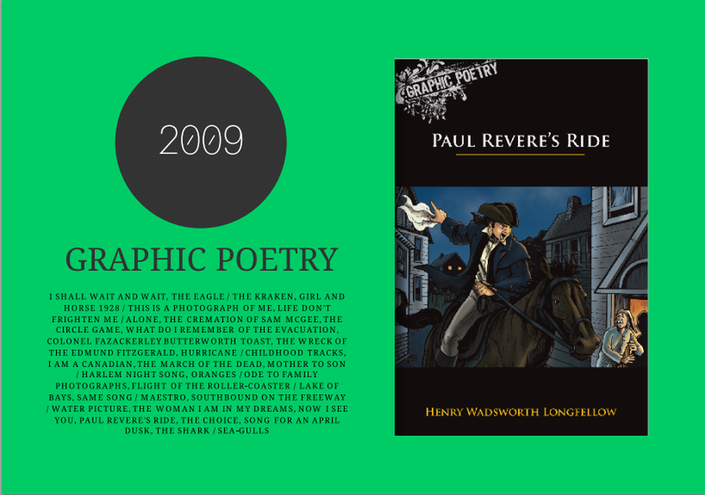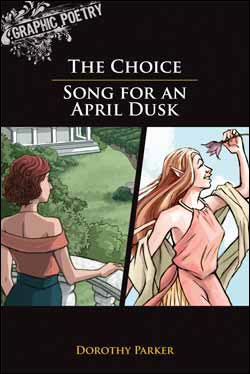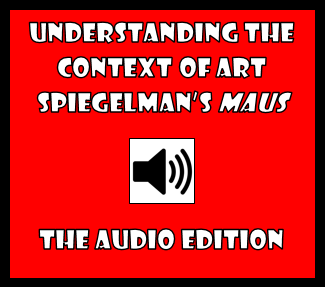The extra-diegetic gaze, which is when a character presented in a photograph, comic, advertisement, film, or other visual medium appears to look out of the frame and often at the reader, is used to great effect in Persepolis. Satrapi’s most frequent use of the extra-diegetic gaze is in creating an emotional connection with the reader in order to deliver a more impactful message. One example of this is on page 48, when Marjane tells another girl named Laly that her father, who is allegedly “on a trip,” is actually dead. Were Marji simply to tell Laly that “on a trip” is synonymous with “dead” in the drawn style of the first frame, the reader would view the whole scene from a somewhat detached, third-person perspective. But when the second frame switches to Laly’s own perspective and Marji looks beyond the frame at the reader, we are now forced to experience the news from the former’s point of view. The direct eye contact and facial expression make the viewer feel part of a real world conversation rather than simply a witness to the one that Satrapi has drawn. This makes for a much more realistic experience of the exchange between the two girls. Satrapi in this instance uses the extra-diegetic gaze to enhance the impact of the scene and to create an emotional connection between the reader and the characters. Another less common use of the extra-diegetic gaze is to isolate a single character from the other characters in a scene. By making the character look outside of the frame, they appear isolated from the people and things within it. In the example above, Marjane lies and says that she is French, not Iranian, in order to avoid discrimination. This causes her to feel guilty and alienated from both the people she lives among and her own culture. This is shown in the second frame, where Marjane looks outside of the panel with an unhappy expression on her face. The extra-diegetic gaze allows us to connect more easily with her guilt and sadness, but it also serves to place her back to the other people in the shot. This creates a clear divide between them, mirroring the isolation Marjane feels. Once more, the extra-diegetic gaze reinforces the ideas and themes Satrapi is exploring. If you plan to cite this article, use the following citation: Lazzam, David. "What Are You Looking At? The Extra-Diegetic Gaze in Marjane Satrapi's Persepolis." Comics in Education, 28 Feb. 2015. Web. If you enjoyed this article you might also enjoy...
0 Comments
Series Titles There are 21 titles in the Graphic Poetry series from Rubicon / Scholastic. Click on one of the images below to scroll through the various titles. As well, on the homepage for the series, each of the books has a look inside feature. Click here to visit the site. THE CIRCLE GAME by Joni Mitchell, ed. by Glen Downey On the carousel of life, history often repeats itself and people find comfort in tradition and familiar experiences. In these poignant lyrics, folk music legend Joni Mitchell shows that we cannot return to the past but we can appreciate every moment of our lives. COLONEL FAZACKERLEY BUTTERWORTH-TOAST by Charles Causley, ed. by Glen Downey When Colonel Fazackerley Butterworth-Toast buys a castle for himself, he doesn't realize that he's bought more than he bargained for! Find out what happens when the Colonel meets one of the castle's oldest residents. THE CREMATION OF SAM MCGEE by Robert Service, ed. by Glen Downey Have you ever been so cold that you'd do anything just to get warm? In this classic poem, Robert Service tells the story of Sam McGee, who finds himself deep in the Canadian Arctic, dreaming of his home in Tennessee. THE WRECK OF THE EDMUND FITZGERALD by Gordon Lightfoot, ed. by Glen Downey In this haunting ballad, legendary folk musician Gordon Lightfoot describes what happens when the Edmund Fitzgerald meets the "Gales of November" on Lake Superior. WHAT DO I REMEMBER OF THE EVACUATION by Joy Kogawa, ed. by Glen Downey In this poignant poem, Joy Kogawa revisits a painful period from her childhood -- when she and her family and other Japanese Canadians were placed in internment camps during World War II. HURRICANE / CHILDHOOD TRACKS by James Berry, ed. by Glen Downey Truly great poets have the ability to transport readers into the world of the speaker -- so get ready to pack your bags! Whether James Berry is writing about the fury of a hurricane or walking the reader through memories of his own childhood, his poems bring the sights, smells, and sounds of Jamaica to life. I AM A CANADIAN by Duke Redbird, ed. by Glen Downey There are great poems written by Canadians, and great poems about Canada. However, none show off the pride we have in the breadth, diversity, and beauty of Canada and its people more than Duke Redbird's "I Am a Canadian." LIFE DOESN'T FRIGHTEN ME / ALONE by Maya Angelou, ed. by Glen Downey In these emotional and inspiring works, Maya Angelou shows how the right attitude and the love and support of friends and family can help people confront and overcome all of life's obstacles. THE MARCH OF THE DEAD by Robert Service, ed. by Glen Downey The Second Boer War is over and the soldiers have come home victorious. People line the streets to celebrate as the men march proudly on parade. But then, the air is filled with another sound -- an eerie reminder from another group of men who also wish to be remembered... MOTHER TO SON / HARLEM NIGHT SONG by Langston Hughes, ed. by Glen Downey In "Mother to Son" and "Harlem Night Song," renowned American poet Langston Hughes captures the struggles, challenges, beauty, and soul of Harlem — one of the most dynamic neighbourhoods in America. ORANGES / ODE TO FAMILY PHOTOGRAPHS by Gary Soto, ed. by Glen Downey In "Oranges" and "Ode to Family Photographs," Gary Soto gives us a bird's-eye view of those weird but charming moments that bring meaning into our lives. THIS IS A PHOTOGRAPH OF ME / GIRL AND HORSE, 1928 by Margaret Atwood, ed. by Glen Downey In these two poems, renowned Canadian author Margaret Atwood delves deep to reveal that things aren't always what they seem. FLIGHT OF THE ROLLER-COASTER / LAKE OF BAYS by Raymond Souster, ed. by Glen Downey In "Flight of the Roller-Coaster" and "Lake of Bays," Raymond Souster takes us out for a day at the carnival and for a walk across a bridge, and provides us with moments that we will likely never forget. SAME SONG / MAESTRO by Pat Mora, ed. by Glen Downey Each and every day, we are influenced by the people we interact with and by the world around us. These influences can be positive or negative but every person is subject to them. In these two poems, Pat Mora explores insecurities and inspiration — common themes we can all relate to. SOUTHBOUND ON THE FREEWAY / WATER PICTURE by May Swenson, ed. by Glen Downey Poet May Swenson had a unique perspective on the world. Whether she was describing a reflection in a pond or cars racing down a highway, Swenson's creative imagery helped people see everyday occurrences in a whole new way. THE CHOICE / SONG FOR AN APRIL DUSK by Dorothy Parker, ed. by Glen Downey Dorothy Parker was a girl with attitude. Her wit and talent for biting sarcasm could easily put those around her to shame. Here, Parker's pretty, poetic lines take a sudden turn that keeps readers on their toes. THE SHARK / SEA-GULLS by E. J. Pratt, ed. by Glen Downey We see animals all the time, but how often do we take a long, hard look at them? In the first poem, E.J. Pratt takes us on a terrifying trip through the harbour. In the second poem, he shows us the unexpected beauty of seagulls in flight. THE EAGLE / THE KRAKEN by Alfred Tennyson, ed. by Glen Downey Ever wondered what it would be like to soar with an eagle or travel to the bottom of the ocean to visit an ancient sea monster? You won't need wings or swimming gear when you read these breathtaking classics by Alfred Tennyson! I SHALL WAIT AND WAIT by Alootook Ipellie, ed. by Glen Downey In this captivating poem by Inuit writer Alootook Ipellie, we get an unforgettable lesson in the importance of patience, determination, and dedication to a goal. THE WOMAN I AM IN MY DREAMS / NOW I SEE YOU by Maxine Tynes, ed. by Glen Downey In "The Woman I Am in My Dreams" and "Now I See You," poet Maxine Tynes shows us how much we can learn about ourselves and others, just by taking the time to look, to consider, and to dream. PAUL REVERE'S RIDE by Henry Wadsworth Longfellow, ed. by Glen Downey The sounds of troops approaching, guns being fired, and a single horse's hooves pounding the pavement bring Paul Revere's famous "midnight ride" to life in this action-packed poem.
The Prezi Here it is, for those of you at RFTLOI who weren't able to make it to the presentation today. Enjoy, and make sure to check out "Best Class Ever!" tomorrow afternoon! The Presentation Handout Here's the presentation handout for "Fostering Inquiry One Comic Book at a Time!" I'll leave this up on the site to give all RFTLOI attendees a chance to check it out! |
Glen DowneyDr. Glen Downey is an award-winning children's author, educator, and academic from Oakville, Ontario. He works as a children's writer for Rubicon Publishing, a reviewer for PW Comics World, an editor for the Sequart Organization, and serves as the Chair of English and Drama at The York School in Toronto. If you've found this site useful and would like to donate to Comics in Education, we'd really appreciate the support!
Archives
February 2019
|




























 RSS Feed
RSS Feed
